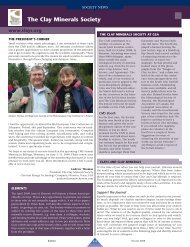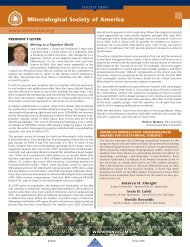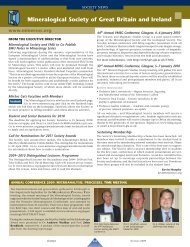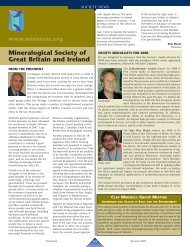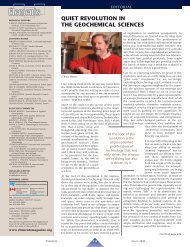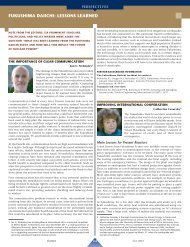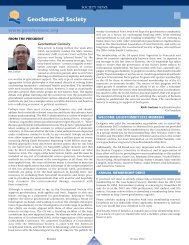MinerSoc - Elements Magazine
MinerSoc - Elements Magazine
MinerSoc - Elements Magazine
You also want an ePaper? Increase the reach of your titles
YUMPU automatically turns print PDFs into web optimized ePapers that Google loves.
Mineralogical Society of Great Britain and Irelandwww.minersoc.orgThe Mineralogical Society and <strong>Elements</strong>A small number of volunteers has been recruitedto help provide interesting material for inclusionin the Mineralogical Society pages of <strong>Elements</strong>. KymJarvis of Imperial College London offered the firstsuch contribution, ‘The Nuclear Question’, in theFebruary 2009 issue. The latest offering is byCaroline Peacock of Southampton University.Sorption and incorporation of trace metals atmineral surfaces is a key control on the reactivityand cycling of trace-metal species in complexCaroline Peacock biogeochemical systems. As such, a fundamentaland quantitative understanding of metal–mineralinteractions is central to describing,explaining and predicting a wide range of Earth and ocean processes.Increasingly, a multi-disciplinary approach is required to determinethe complex interplays among mineralogical, physiochemical and biogeochemicalfactors responsible for the sorption, subsequent retentionand stable isotope fractionation of key geo-relevant trace metals betweennatural solutions and mineral phases. In future issues, I will be highlightingexciting new research at the mineral–water interface, withparticular focus on new molecular-level insights on metal–mineralinteractions. Armed with an ever-improving knowledge of the smallscaleprocesses that control the chemical reactivity of trace metalsbetween minerals and natural waters, we are better able to determinesome of the key controls on large-scale freshwater and marine chemistryand use the natural record of this chemistry in mineral phases to helpexplain the operation of Earth processes in the past and predict theresponse of these processes to future physical and chemical change.CLAY MINERALS’ ASSOCIATE EDITOR PANELCaroline PeacockManuscripts submitted to ClayMinerals – Journal of Fine ParticleScience are handled by the PrincipalEditor, John Adams, and a panel ofAssociate Editors. There have been severalchanges to the panel recently, withthe appointment of new editors from theUnited States, Australia, Spain andGreece. Below are some short notesabout the panel. Papers for the journalshould be submitted to specificAssociate Editors or to the PrincipalEditor. See the journal’s notes for theguidance of authors at www.minersoc.org/pages/e_journals/cm_authors.pdf.David Bish is the Haydn Murray Chair of AppliedClay Mineralogy at Indiana University inBloomington, Indiana, USA. His research groupfocuses on a variety of mineralogical problems,both terrestrial and extraterrestrial, using a combinationof X-ray powder diffraction, thermalanalytical, calorimetric and isotopic methods. Hehas a long-standing interest in natural zeolites,their formation mechanisms, and the structural and thermodynamicnature of dehydration-induced phase transitions. He hasalso studied the interaction of hydrous minerals, including smec-tites and zeolites, with H 2 O, focusing on the behaviour of hydrousminerals on the surface of Mars. A new research area is the studyof naturally occurring organic compounds in clay minerals.Chris Breen is Professor of Materials Chemistryat Sheffield Hallam University. He has worked onclay–organic complexes for over thirty years. Hisinterests include acid-treated clays as catalysts,clay–organic interactions, and, more recently, theproduction, characterisation and use of clay-basedpolymer nanocomposites. These materials offersignificant enhancements in mechanical, barrierand fire-resistant properties, and Chris is particularly involved inthe study of these systems for the transport, construction andpackaging sectors. Chris has been happily married to Catherinefor 27 years, is the proud father of 4 strapping lads and likes tobuild things out of wood – much to the amusement of his family.George E. Christidis is Associate Professor ofEconomic Geology–Industrial Mineralogy in theTechnical University of Crete, Greece. His researchfocuses on the study of the formation and growthof smectites in bentonites; the properties andindustrial and environmental applications ofnatural and chemically modified clays, zeolitesand industrial fillers; and the synthesis of purezeolites. He is currently studying geological and geochemical factorscontrolling the distribution of smectite layer charge in bentonitesand the influence of layer charge on bentonite properties.Juan Cornejo is Research Professor in SoilScience at the Instituto de Recursos naturales yAgrobiología de Sevilla, Spain. He possesses wideexperience in research on the surface and texturalproperties of clays and clay minerals. Clays andlayered double hydroxides before and after organicmodifications have been extensively studied forcontaminated soil and water remediation and asslow-release pesticide formulations. He is working on the fate ofpesticides in soil–water–sediment systems, and his recent researchactivities have dealt with multi-disciplinary national and Europeanprojects related to the study of factors and processes affecting theadsorption–desorption, degradation and transport of chemicals(especially pesticides) in soils. He is the author or co-author of 125refereed (SCI) papers and another 100 refereed scientific publications.Enver Murad – After stumbling through aberrationslike petrofabric analysis, Enver finally arrived– via soil science – at the ultimate superlative ofgeoscientific work: clay mineralogy. Althoughalmost everybody uses the hackneyed term “nanophase”,this is and remains the only suitable characterisationof the active constituents of soils.Working with museum-class minerals may be fun,but unravelling the secrets of nature’s own nanophase materialsusing the necessarily complex techniques to characterise this difficultstuff has proven considerably more challenging and in the endmore satisfying for him. Clay mineralogy being a border discipline,touching not only on clay minerals sensu stricto but also on theindustrial applications of clays and related fields such as catalysis,makes this work even more interesting. Enver works at the TechnischeUniversität München, and his principal field of specialisation insoil and clay mineralogy is Mössbauer spectroscopy.El e m e n t s 128Apr i l 2009
Balwant Singh is an Associate Professor in theFaculty of Agriculture, Food and Natural Resourcesat the University of Sydney. Balwant’s researchinterests include the understanding of mineralstructure and chemical reactions of minerals insynthetic and natural systems, with an emphasison heavy metals.Frédéric Villiéras is a CNRS Research Directorat the Laboratoire Environnement et Minéralurgie(Nancy, France) and has internationally recognizedexperience in the characterisation and modellingof the surface reactivity of solids in a varietyof geological materials. His research activities concernthe relationship between structural propertiesand surface heterogeneity of clay mineralsand related materials. One of the main achievements of his researchis the determination of basal and edge surface areas of clay mineralsfrom argon low-pressure adsorption. Another part of his researchconcerns clay swelling and reactivity related to radioactive wastedisposal in deep clay rocks.Laurence Warr is a professor of economicgeology at the Institute for Geography and Geologyof the University of Greifswald in Germany.His research interests focus on the study of clayminerals and other fine-grained minerals formedunder diverse geological conditions. His currentprojects cover a range of topics including diagenesisand very low-grade metamorphism, bacteria–clay interaction and the bioremediation of oil spills, the formationof bentonite and its use in the disposal of nuclear waste, and theMinersoc_AdLandmarkIII:Minersoc_AdLandmark3 role of clays other fine particles seismically active 4/16/09 faults. 4:24 PM Page 1Laurence also develops analytical tools for the in situ monitoringof fine-particle reaction kinetics in solution by X-ray diffractiontechniques.3N U M B E RAVAILABLEFROM THE MINERALOGICAL SOCIETYThe key benefit in the Landmark seriesis the commentaries by guest editors. Bernard Evans, inthis case, places in context the chosen works and describes how theycontributed to the advancement of the science. He weaves a fascinating tale.“Many metamorphic rocks are attractive in appearance, in hand specimen andin thin section under the microscope. Their aesthetic appeal touches sensesbeyond the merely scientific, a pleasure that most geochemists forego. Addedto this is the satisfaction we derive as they reveal each new instance of nature’sfidelity to scientific laws. But the aesthetic appeal comes at a cost. Metamorphicpetrologists need to be adept in very many things: crystal chemistry, physicalchemistry, phase equilibria, microscopy, textural analysis, regional geology,structural geology, geodynamics and geochronology.”PLEASE SEND YOUR ORDER TOThe Mineralogical Society12 Baylis Mews, Amyand Park RoadTwickenham TW1 3HQ, UKTel.: +44 (0)208 891 6600Fax: +44 (0)208 891 6599E-mail: info@minersoc.orgLIST PRICE: £32 or $60MEMBERS PRICE:£18/$36Please add postageUK £5.95/$10Europe £9.95/$20RoW £15.95/$30New Views of the Earth’s Interior– Meeting ReportThe legendary pugilist Muhammed Ali said, “The man who views theworld at fifty the same as he did at twenty has wasted thirty years ofhis life.” Our scientific understanding of the Earth shows no suchfailing, amply demonstrated by the recent ‘New Views on the Earth’sInterior’ meeting held in the Geological Society premises in Londonin February 2009. This event, jointly supported by the BritishGeophysical Association and the Mineralogical Society of Great Britainand Ireland (through the Mineral Physics Group), certainly justifiesthe plural in the title, as it brought together eminent geochemists,mineral physicists, geodynamicists and seismologists from around theworld to discuss recent developments in the study of our planet andbeyond. The themes of discussion covered a broad chunk of the Earth’sinterior, from the crust to the remotest inner core, and out into space.Perspectives were provided from theoretical, experimental and observationalview points. Observations are provided by geochemistry andseismology: the images provided by seismology have recently beenvastly enhanced by the availability of dense-array data.Sebastian Rost (Universityof Leeds), BullerwellLecturer, at the ‘NewViews on the Earth’sInterior’ meetingPresenters showed new, high-resolution imagesof continental lithosphere, subducting slabs,the transition zone, the enigmatic lowermostmantle region and the solid iron inner core.Seismology, however, primarily reveals velocityin the media it images. To convert this into anunderstanding of the building blocks of theEarth requires input from mineral physics, todescribe the nature and behaviour of materialsat interior conditions. For example, computationalab initio methods directly model thequantum mechanical behaviour of materials atthe atomistic level: these are being used toexplore the crystal structure which is presentin the inner core and the possibility of melt inthe deep mantle. To study real samples, experimentalistsmust reproduce the vast pressuresand temperatures in the planet’s interior, whichis accomplished in large presses for the transition zone and using diamondanvil cells for the deep core. Results from such experimentsexploring the nature of mineral phase changes at the top and bottomof the mantle were presented, as were new insights into the chemistryof the core. Finally, the understanding provided by experiments andcomputation are being combined in complex simulations of the thermaland chemical dynamics of the whole Earth: such predictions can becompared with the observations from seismology and geochemistry.The presentations and surrounding discussions underlined a centraltheme: that the progress we have made and still desire to make requirescollaborative effort across a number of disciplines and that such activitiesare only increasing in scope. This ensures that our views of theEarth’s interior will continue to evolve and allow synonymous conferencesin the future.J. WookeyMember of the Organizing CommitteeMAPT – MicroAnalysis, Processes, TimeOnline registration for MAPT is now open.Go to www.minersoc.org/pages/meetings/MAPT/MAPT.html for information aboutthe two short courses, the two field tripsand the 17 thematic sessions taking placeover three days in wonderful Edinburgh.Further information is availablefrom Simon Harley, convenor(s.harley@ed.ac.uk).www.minersoc.orgEl e m e n t s 129Apr i l 2009




